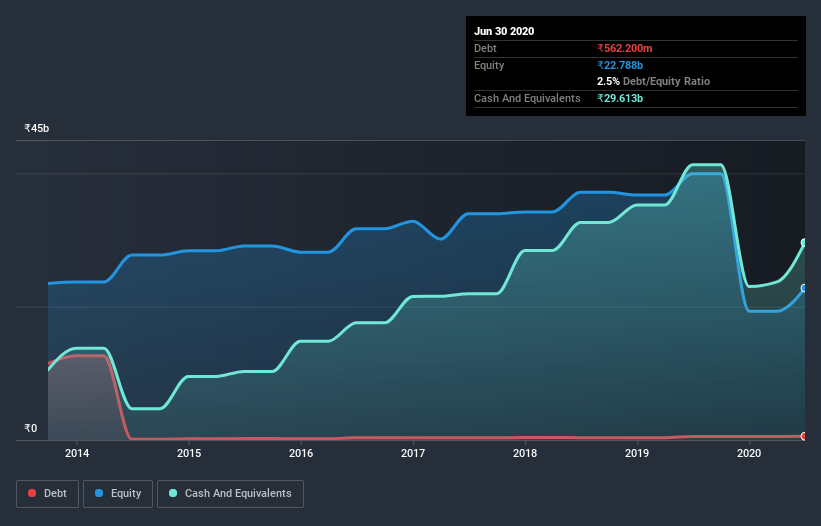
Legendary fund manager Li Lu (who Charlie Munger backed) once said, 'The biggest investment risk is not the volatility of prices, but whether you will suffer a permanent loss of capital.' So it might be obvious that you need to consider debt, when you think about how risky any given stock is, because too much debt can sink a company. As with many other companies Nestlé India Limited (NSE:NESTLEIND) makes use of debt. But should shareholders be worried about its use of debt?
What Risk Does Debt Bring?
Debt assists a business until the business has trouble paying it off, either with new capital or with free cash flow. Ultimately, if the company can't fulfill its legal obligations to repay debt, shareholders could walk away with nothing. While that is not too common, we often do see indebted companies permanently diluting shareholders because lenders force them to raise capital at a distressed price. Of course, plenty of companies use debt to fund growth, without any negative consequences. The first thing to do when considering how much debt a business uses is to look at its cash and debt together.
See our latest analysis for Nestlé India
What Is Nestlé India's Net Debt?
As you can see below, at the end of June 2020, Nestlé India had ₹562.2m of debt, up from ₹515.2m a year ago. Click the image for more detail. However, its balance sheet shows it holds ₹29.6b in cash, so it actually has ₹29.1b net cash.

How Healthy Is Nestlé India's Balance Sheet?
According to the last reported balance sheet, Nestlé India had liabilities of ₹25.8b due within 12 months, and liabilities of ₹32.5b due beyond 12 months. On the other hand, it had cash of ₹29.6b and ₹2.22b worth of receivables due within a year. So it has liabilities totalling ₹26.5b more than its cash and near-term receivables, combined.
Having regard to Nestlé India's size, it seems that its liquid assets are well balanced with its total liabilities. So while it's hard to imagine that the ₹1.56t company is struggling for cash, we still think it's worth monitoring its balance sheet. Despite its noteworthy liabilities, Nestlé India boasts net cash, so it's fair to say it does not have a heavy debt load!
The good news is that Nestlé India has increased its EBIT by 5.9% over twelve months, which should ease any concerns about debt repayment. There's no doubt that we learn most about debt from the balance sheet. But it is Nestlé India's earnings that will influence how the balance sheet holds up in the future. So if you're keen to discover more about its earnings, it might be worth checking out this graph of its long term earnings trend.
But our final consideration is also important, because a company cannot pay debt with paper profits; it needs cold hard cash. Nestlé India may have net cash on the balance sheet, but it is still interesting to look at how well the business converts its earnings before interest and tax (EBIT) to free cash flow, because that will influence both its need for, and its capacity to manage debt. During the last three years, Nestlé India produced sturdy free cash flow equating to 76% of its EBIT, about what we'd expect. This free cash flow puts the company in a good position to pay down debt, when appropriate.
Summing up
We could understand if investors are concerned about Nestlé India's liabilities, but we can be reassured by the fact it has has net cash of ₹29.1b. The cherry on top was that in converted 76% of that EBIT to free cash flow, bringing in ₹17b. So we don't think Nestlé India's use of debt is risky. There's no doubt that we learn most about debt from the balance sheet. However, not all investment risk resides within the balance sheet - far from it. Be aware that Nestlé India is showing 1 warning sign in our investment analysis , you should know about...
If you're interested in investing in businesses that can grow profits without the burden of debt, then check out this free list of growing businesses that have net cash on the balance sheet.
If you’re looking to trade Nestlé India, open an account with the lowest-cost* platform trusted by professionals, Interactive Brokers. Their clients from over 200 countries and territories trade stocks, options, futures, forex, bonds and funds worldwide from a single integrated account. Promoted
Valuation is complex, but we're here to simplify it.
Discover if Nestlé India might be undervalued or overvalued with our detailed analysis, featuring fair value estimates, potential risks, dividends, insider trades, and its financial condition.
Access Free AnalysisThis article by Simply Wall St is general in nature. It does not constitute a recommendation to buy or sell any stock, and does not take account of your objectives, or your financial situation. We aim to bring you long-term focused analysis driven by fundamental data. Note that our analysis may not factor in the latest price-sensitive company announcements or qualitative material. Simply Wall St has no position in any stocks mentioned.
*Interactive Brokers Rated Lowest Cost Broker by StockBrokers.com Annual Online Review 2020
Have feedback on this article? Concerned about the content? Get in touch with us directly. Alternatively, email editorial-team@simplywallst.com.
About NSEI:NESTLEIND
Nestlé India
Manufactures and sells food products in India and internationally.
Outstanding track record with adequate balance sheet and pays a dividend.


